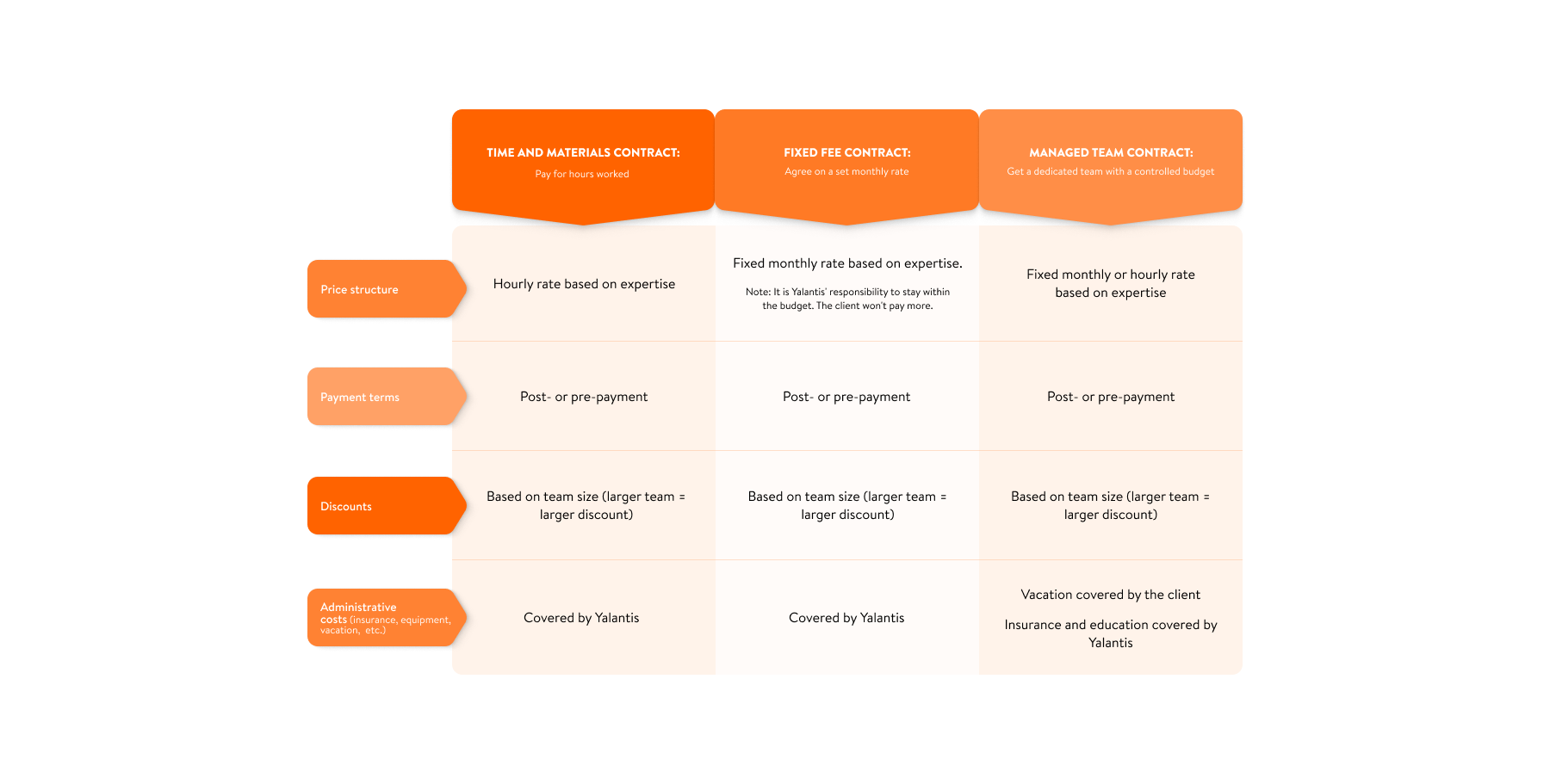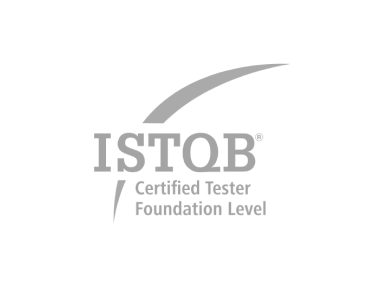Hire QA engineers
Release bulletproof software faster with top-tier QA experts on board. Expand or create your own QA team, minus recruitment and management stress. Yalantis will assemble your dream QA squad that seamlessly integrates with your culture and goals.
-
8,000+
QA experts in our database
-
300+
Successful client projects in total
-
4.8/5
client satisfaction rating according to Clutch
-
TOP 3
QA communities in Europe
Yalantis QA/ATQC expertise
Ensure your software performs flawlessly, improves user satisfaction, and meets industry standards with Yalantis’ extensive expertise in quality assurance and automated test quality control.
-
BASIC TESTING
-
Requirements testing, code review
-
Functional testing
-
Compatibility testing
-
UI testing
-
Installation testing
-
Smoke testing
-
Regression testing
-
Confirmation testing
-
Maintenance testing
-
-
EXTENDED TESTING FOR RISK MITIGATION
-
Usability testing
-
Compliance testing
-
Accuracy testing
-
Localization (L10N) testing
-
Internationalization (l18N) testing
-
-
AUTOMATION TESTING FOR EFFICIENCY AND SPEED
-
Unit testing
-
Integration testing
-
API automated testing
-
UI automation testing
-
-
PERFORMANCE TESTING FOR SMOOTH USER EXPERIENCE
-
Reliability testing
-
Scalability testing
-
Load testing
-
Stress testing
-
Volume testing
-
Endurance testing
-
Spike testing
-
-
BASIC TESTING
-
Requirements testing, code review
-
Functional testing
-
Compatibility testing
-
UI testing
-
Installation testing
-
Smoke testing
-
Regression testing
-
Confirmation testing
-
Maintenance testing
-
-
EXTENDED TESTING FOR RISK MITIGATION
-
Usability testing
-
Compliance testing
-
Accuracy testing
-
Localization (L10N) testing
-
Internationalization (l18N) testing
-
-
AUTOMATION TESTING FOR EFFICIENCY AND SPEED
-
Unit testing
-
Integration testing
-
API automated testing
-
UI automation testing
-
-
PERFORMANCE TESTING FOR SMOOTH USER EXPERIENCE
-
Reliability testing
-
Scalability testing
-
Load testing
-
Stress testing
-
Volume testing
-
Endurance testing
-
Spike testing
-
DON’T SHIP BUGS — SHIP EXCELLENCE
Enlist expert QA support in several days — without the hassle of direct onboarding and management.
Why hire QA specialists with Yalantis
-
QUICK ACCESS TO TOP TALENT
Need domain-specific knowledge or niche technical skills? Yalantis will match you with the best-fitting QA engineers within days based on your project and candidate requirements.
-
TEAM INTEGRATION THAT FITS YOUR CULTURE
Get a team that adapts to your operational processes. Our QA experts adjust to your workflows and embrace your company values. You choose the candidates, and Yalantis onboards them with your business goals.
-
QUALITY AT SPEED
Maintain and enhance your development pace, not sacrificing quality. Yalantis QA experts use our proprietary AI tools that reduce defect rates by 18% compared to traditional software development processes that don’t use AI. This helps them maintain your delivery times while enhancing quality.
-
REGULAR REPORTS AND UPDATES
Focus on high-level strategy and growth while delegating day-to-day project management to Yalantis. We ensure transparency and visibility through regular project updates, showcasing our progress and engagement.
-
FLEXIBLE TEAM SCALING
Swiftly adjust your QA team size to match project demands. Add specialists for critical phases or reduce the team post-launch — Yalantis efficiently handles the logistics to meet your changing needs.
-
DIVERSE INDUSTRY KNOW-HOW
Enlist QA specialists with broad experience. Our experts have tackled challenges in 300+ projects across multiple industries. They spot potential issues early, cutting down troubleshooting time and costs.
Flexible collaboration models


UNLOCK PREMIUM QA TALENT ON DEMAND
Whether you need one specialist or a full team, we’ll align top QA talent with your project goals and culture.
Technologies we work with
MANUAL TESTING
-
TestRail
-
Xray
-
Zephyr
-
BrowserStack
-
ChromeDevTools
-
Postman
-
Swagger
-
adb
-
simctl
-
Fiddler/Charles
-
XCode
-
Android Studio
AUTOMATED TESTING
-
Java
-
Python
-
JS
-
TestNG
-
JUnit
-
Serenity BDD
-
JBehave
-
Cucumber
-
pytests
-
Maven
-
Gradle
-
pipenv
-
GitLab
-
Docker
-
BrowserStack
-
SauceLab
-
Selenium WebDriver
-
Selenium Grid
-
Selenoid
-
Playwright
-
RestAssured
-
requests
-
Postman
-
jdbc
-
Appium
-
adb
-
simctl
-
JMeter
-
AllureReports
Certifications of Yalantis QA experts
Our projects
-
Home Connect for Bosch
Discover Yalantis’ role in crafting Home Connect for Bosch, a system designed to empower homeowners with effortless and convenient control over their smart kitchens and home devices.
-
Toyota Tsusho
Explore our collaboration with Toyota Tsusho Corporation, a commerce firm within the Toyota Group. Boasting 150+ offices and 900 associates, Toyota Tsusho commands a global footprint.
-
KPMG
Learn how our experts crafted a mobile interaction pathway for a globally recognized consulting firm, enabling users to reach KPMG advisors and solicit immediate callback requests.rn
-
Google X
Learn about our collaboration with X (former Google X), a US Ru0026D factory founded by Google in 2010
-
RAKwireless
Discover how we assisted RAKwireless in creating WisDM, a corporate SaaS product designed for the seamless configuration and administration of extensive IoT infrastructures.
-
Healthfully
Discover how we aided our client in broadening their healthcare enterprise through the fusion of their current patient management system (PMS) with various external electronic health record (EHR) software offerings.
-
Orbis
Discover more about Yalantis’ partnership with Orbis Systems, a FinTech enterprise providing financial advisory services and crafting electronic trading infrastructures, assisting businesses in navigating digital transitions.
-
Duo Health
Discover the creation process behind an MVP patient portal on iOS, Android, and web platforms that propelled Duo Health in enhancing patient dedication and contentment, while broadening their reach across seven American states.
-
Lifeworks Advisors
See how we assisted our client in creating a comprehensive platform for financial advisors and their clients.
-
Stromee
Explore how we developed a GDPR-adherent software tool aimed at enlightening consumers about their energy usage and guiding them towards intelligent power consumption practices.
-
Meroxa
Discover more about our client Meroxa, whom we supported in the realm of software creation.
-
Truhoo
Explore how we assisted a Spanish innovator in creating a multiplatform, SEO-optimized, and GDPR-adherent property platform with sophisticated features and a scalable technological foundation.
-
Wayne
Explore how we boosted a trucking firm’s customer trust, eased employee order management, and cut operational costs by creating a dynamic web customer portal for 24/7 real-time order handling and tracking.
-
123 Sourcing
Discover how we assisted 123 Sourcing in minimizing manual labor and human mistakes, cutting workforce, shipping, and storage expenses, while maintaining existing customers and drawing in new ones through a semi-automated cargo planning system.
-
RestorixHealth
Boosting RestorixHealth’s growth with a scalable, secure, automated patient care management solution.
-
Aironworks
Find out how we supported the development of a web app for a startup focused on cybersecurity awareness.
-
Scholz Databank
Explore the nuances of our partnership with SCHOLZ Databank, a purveyor of a medicinal database utility for healthcare experts and patients in the US and Germany.
-
Foster the City
-
Oxygen
Discover how we helped Oxygen, a leading American neobank address pressing data management challenges with a strategy designed to last
-
Amazing Discoveries
Explore how we increased audience reach for a non-profit with cutting-edge smart TV apps, multiplying user engagement and satisfaction
-
BlueOcean
-
5 and Go!
Discover how we helped 5 and Go! develop a gamified mental health app for iOS
-
Kuba
-
Codeway
-
Reteno
What our clients say
SECURE TOP QA TALENT TODAY TO ELEVATE YOUR SOFTWARE QUALITY
Need a simple mobile app, a massive enterprise system overhaul, or any other solution? Quickly enlist the right technical expertise to bring your idea to life.
More professionals for your projects
-
-
Selenium engineers
- Android developers
-
Cybersecurity experts
- Frontend developers
-
-
- iOS developers
-
Business analysts
- Backend engineers
-
IoT developers
Related insights

How to Implement an Effective IoT Testing Framework
How can you test IoT solutions? Why is performance testing crucial, and what is an Internet of Things testing framework? Let’s figure out what end-to-end IoT testing is in detail.

Best practices to performing testing and quality assurance
We provide you with practical steps for effective quality assurance and outline all types of testing QA experts work on during your project.

How to deal with strict project limitations and achieve high product quality
Learn best practices for dealing with strict project constraints and read about Yalantis’ approach to constraints management to maintain quality.
FAQ
What does a QA tester do?
Based on the expertise of Yalantis’ QA experts, here are the key responsibilities and value-adds of a quality assurance engineer:
- Static testing: Reviews documents and code before execution, preventing early-stage defects. Uniquely performed by QA testers, this process catches issues before they become costly to fix in later stages.
- Fresh and unbiased perspective: Evaluates solutions from a user’s viewpoint, providing essential feedback on usability and user experience.
- Test documentation: Creates comprehensive test plans and cases for thorough evaluation of the product. This documentation is key for maintaining quality across development cycles and facilitating clear communication within the team.
- Impact analysis: Assesses how new features interact with existing functionalities. This helps identify potential conflicts or issues before they affect the end-user.
- Platform compliance: Ensures adherence to specific guidelines (iOS, Android, etc.) for consistent user experience.
- Efficient bug detection: Uses experience from various projects and domains to identify potential issues early, even during exploratory testing.
Why hire QA testers with Yalantis?
Hiring our QA experts delivers a more reliable, user-friendly, and error-free product faster with:
- User-focused software testing: Our QA engineers simulate real user behavior while applying expert insights, uncovering hidden issues.
- Industry know-how: Experience from 300+ projects enables our team to anticipate and prevent common problems in your field.
- Smart software testing strategy: Their tailored QA approach focuses on relevant devices and platforms, catching compatibility issues early.
- Clear progress updates: Regular reports keep you informed about software testing progress, identified issues, and product readiness. Our QA engineers perform:
– positive testing: Verifying features work as intended
– negative testing: Evaluating how a system handles unexpected inputs and scenarios (e.g., internet loss during transactions)
Yalantis’ comprehensive QA approach ensures your product is thoroughly vetted before release, saving time and enhancing user satisfaction.
How do you select candidates? What is your model of hiring QA engineers?
To help you hire QA testing experts, we follow this process:
- We search for candidates matching your requirements from our internal and external pool of 8,000+ QA professionals.
- All candidates undergo internal validation, including:
– technical expertise review
– English proficiency assessment
– soft skills evaluation - The selection process typically takes:
– 3-5 days for internal candidates
– Longer for external candidates or complex requests involving rare technologies or unique skill combinations - We provide regular updates on candidate selection throughout the entire process. You can actively participate in the hiring process if you wish, from reviewing resumes to conducting interviews.
Why hire QA developers with Yalantis: Take a look at their rigorous work process
Yalantis experts divide the software testing process into the following stages, which all contribute to developing a high-quality solution for your business:
- Early QA involvement for catching issues early and reducing costs: Diving into the project requirements before a single line of code is written. This helps catch issues early and save costs on development and bug fixes later in the process.
- Flexible test planning to adapt to the project’s evolving needs: Planning tests for each development cycle (sprint) separately, not all at once. This keeps things agile and adapts to changing product requirements as the client gets feedback and refine their vision. This way, our experts focus on the most critical features and risks each sprint.
- Efficient test design for thorough testing without slowing down development: Using a mix of detailed test cases (title, preconditions, steps to be taken, and expected results) for complex scenarios and test checklists for basic user flows. This helps maintain development speed by reducing the time spent on test documentation while still ensuring thorough coverage.
- Setup of test environment to minimize delays: Ensuring the software testing environment is ready to go when new features are complete. For example, this includes preparing a test device with a certain version of an operating system, reducing operational delays that could occur if testers had to set up environments for each test run.
- Complex test execution for a balanced approach. Using both manual and automated testing (we cover what those are later in text) to cover all aspects of the product, from front-end functionality to back-end performance and security.
- Test stats tracking to get clear metrics: Using testing tools like TestRail to track all test stats. This provides concrete KPIs the client can be after, like test coverage, pass/fail rates, and the number of bugs caught before release. Without these metrics, clients struggle to track the solution’s progress effectively and might miss critical insights about its quality and readiness.
Finally, Yalantis’ QA experts use tools like Jira and TestRail to track bugs and provide detailed reports on software testing progress and results. This clear and timely reporting keeps you informed about progress, risks, and overall product quality. It also helps you measure the impact on customer satisfaction by giving us a clear view of what’s been tested and improved in each release.
27 types of testing Yalantis’ QA experts perform and their business value
Yalantis’ experts cover a comprehensive suite of QA services to ensure your product’s quality and success. They apply:
- basic testing to ensure that the core functionality of your solution works as expected
- extended testing to ensure that a solution is robust, reliable, and secure in a variety of real-world scenarios
Let’s take a closer look at both these testing approaches.
Basic testing types
Yalantis QA experts perform these main basic testing types:
- Static testing (requirements testing): Reviewing requirements and design documents to catch issues before development begins, saving time and money; checking that solution requirements are complete and consistent.
- Functional testing: Verifies that each function of the software works according to the specification.
- Smoke testing (build verification testing): Quick stability checks after changes or updates to the software, such as bug fixes, feature changes, or server migrations.
- Basic usability testing: Evaluates how user-friendly and intuitive the software is from an end-user perspective.
- Compatibility testing: Ensures the software works correctly across different devices, operating systems, and browsers.
- User interface (UI) testing: Checks the graphical user interface to ensure it meets specifications and design standards.
- Installation testing: Verifies that the software installs correctly, with all features properly set up and functioning as expected across different environments.
- Confirmation testing: Re-testing a specific test case that previously failed to confirm that the issue has been fixed.
- Maintenance testing: Ongoing testing to ensure the software remains stable and functional over time.
- Regression testing: Ensures that previously developed and tested software still performs correctly after changes. Unlike smoke testing, which is a quick check of critical functionalities, regression testing is more comprehensive, covering a wider range of features to ensure new changes haven’t negatively impacted existing functionality.
Extended testing types
As for extended testing, these are its main types Yalantis QA experts perform:
- Unit testing: Checks individual parts of the code to ensure they work as expected in isolation.
- Integration testing: Verifies that different modules or components of the software system work together correctly. This ensures that various parts of the application, such as different microservices, databases, APIs, or user interface elements, interact properly when combined.
- Automated API testing: Using automated scripts to verify that the software’s underlying communication channels are functioning correctly.
- UI automation testing: Simulates user interactions to ensure the interface is easy to use and error-free.
- Extended usability testing: Evaluates the system’s ease of use from an external user’s perspective.
- Compliance testing: Ensures the software adheres to relevant standards, regulations, and laws.
- Accuracy testing: Verifies the system provides correct results with required precision.
- Localization (L10N) testing: Checks how well the application is adapted for a specific target language and culture.
- Internationalization (I18N) testing: Ensures proper display of language-specific characters and formats across different locales.
- Reliability testing: Determines if the software performs required functions under specified conditions over time.
- Scalability testing: Confirms that the software can handle increased traffic and user loads without breaking down.
- Performance testing: Ensures the system functions efficiently within given constraints.
- Load testing: Checks how the software performs under heavy traffic or usage.
- Stress testing: Assesses system behavior beyond anticipated workloads or with limited resources.
- Volume testing: Tests software performance with large amounts of data.
- Endurance testing: Testing how the software performs over long periods of use.
- Spike testing: Seeing how the software reacts to sudden spikes in user traffic.
How these testing types translate into tangible business value
Risk mitigation and cost savings. Static testing and functional testing catch issues early, reducing expensive post-release fixes. Regression and smoke testing prevent unexpected issues from new changes, saving time and resources on bug fixes, customer support, and potential loss of revenue due to software failures.
Enhanced user satisfaction and retention. Usability and UI testing ensure a positive user experience by identifying and resolving navigation issues, confusing interfaces, or inconsistent design elements. Compatibility testing broadens your market reach by ensuring your product works across various platforms.
Improved product quality and reliability. Unit, integration, and API testing ensure each part of your software works correctly, both individually and together. Reliability and endurance testing confirm your product can perform consistently over time, building trust with users.
Compliance and global market readiness. Compliance testing helps avoid legal issues and opens up regulated markets. Localization and internationalization testing prepare your product for global markets by ensuring proper language translation, cultural appropriateness, and correct handling of region-specific data formats.
Performance and scalability assurance. Performance, load, stress, and scalability testing ensure your product can handle growth and peak usage times. This prevents costly outages and maintains user satisfaction during high-traffic periods.
Operational efficiency. Automated testing (UI, API) allows for faster development cycles and quicker time-to-market. Maintenance and confirmation testing keep your product stable over time, reducing support costs such as customer service staff, bug fixing resources, and potential compensation for service disruptions.
Data integrity and accuracy. Accuracy and volume testing ensure your product handles data correctly. In turn, accurate data prevents costly errors in financial transactions, inventory management, or user analytics that could lead to poor strategic choices.
Adaptability to market changes. Spike testing helps prepare for sudden increases in demand, allowing you to capitalize on unexpected opportunities. By simulating sudden traffic surges, you can ensure your system remains stable during viral marketing campaigns, product launches, or unexpected market shifts.
By going for comprehensive QA testing, you’re not just improving your software — you’re protecting your brand reputation, enhancing user satisfaction, reducing operational costs, and positioning your product for sustainable growth in a competitive market.
Test automation: Smart efficiency, not just for the sake of it
Yalantis’ QA engineers recognize the importance of efficiency in the testing process. This is where test automation comes into play, offering a powerful solution for repetitive and time-consuming testing tasks. It’s not about replacing human testers. Rather, it’s about making their lives easier and letting them focus on the complex stuff that requires human judgment and creativity.
We recommend automated test quality control (ATQC) to clients only when it’s necessary for their project. When you hire software QA testers with us, we customize our approach to meet each client’s needs, ensuring efficient use of resources and budget.
Test automation approach at Yalantis
Our experts implement automation for main user flows in long-term projects, particularly those frequently undergoing changes or feature additions. This approach offers several benefits:
- Time efficiency: Automated tests replace repetitive manual checks, allowing QA specialists to focus on complex, custom scenarios.
- Consistency: Automated tests perform identical checks each time, reducing human error.
- Targeted automation: We carefully select which tests to automate based on frequency, complexity, and project needs.
When is test automation a good idea?
Automation is most beneficial for frequently run tests, time-consuming tests, and those scheduled for off-hours execution. The automation approach is also tailored to the specific type of testing:
- Regression tests: Automate key user scenarios to ensure new changes don’t break existing functionality.
- Smoke tests: Get quick feedback on a product’s stability after updates with automated smoke tests.
- Data-driven tests: Automate tests that need to be run with various inputs or large amounts of data.
Performance/load tests: These tests must be automated to simulate real-world user loads and stress conditions.
Not all tests should be automated, though. Yalantis QA experts avoid automating:
- User experience and usability tests that need human feedback
- Tests that can’t be fully automated, such as:
– Tests requiring physical device interactions (e.g., testing phone call interruptions)
– Tests involving captcha or two-factor authentication
– Tests for subjective visual elements like color gradients or animation smoothness - One-time tests or those needing immediate execution
These types of tests are more effective when done manually because:
- they require human judgment and perception, which automated testing tools can’t replicate accurately
- they often involve unpredictable scenarios or subjective assessments that are difficult to program
- manual testing allows for real-time observations and immediate adjustments based on user behavior or unexpected issues
- human testers can provide valuable qualitative feedback and insights that automated tests might miss
Types of automated tests we use
- Backend tests:
– Used for API, integration, and database testing
– Detect bugs early in development - Graphical user interface (GUI) and end-to-end (E2E) tests:
– For web and mobile platforms
– Simulate real user interactions
– Test complete business scenarios
– GUI tests are good for catching visual bugs and ensuring the UI is working as expected
– E2E tests are better for verifying the overall functionality and flow of the system
Manual QA specialists create test cases, then ATQC specialists automate selected tests. We integrate these automated tests into our continuous integration and continuous delivery (CI/CD) processes. This integration allows for regular, automatic execution of tests whenever code changes are pushed to our shared repository. By doing so, we can quickly catch bugs, reduce manual work, and accelerate our product release cycles.
While powerful, test automation isn’t always cost-effective, especially for smaller projects. We carefully assess each project’s needs, automating only where it provides clear benefits. By strategically incorporating test automation, we improve our QA process, ensuring both thoroughness and efficiency in software testing.
A balanced testing approach
The most successful QA strategies use a mix of manual and automated testing:
- Manual testing is essential for exploring new features, evaluating user experience, and finding those tricky edge cases that automated tests might miss.
- Automated testing takes over the repetitive tasks, freeing up human testers to do what they do best – think critically, solve problems, and advocate for the best possible user experience.
Collaborate with Yalantis

got it!
Keep an eye on your inbox. We’ll be in touch shortlyrnMeanwhile, you can explore our hottest case studies and readrnclient feedback on Clutch.
See Yalantis reviews
Nick Orlov
Engagement Manager
Your steps with Yalantis
-
Schedule a call
-
We collect your requirements
-
We offer a solution
-
We succeed together!









































